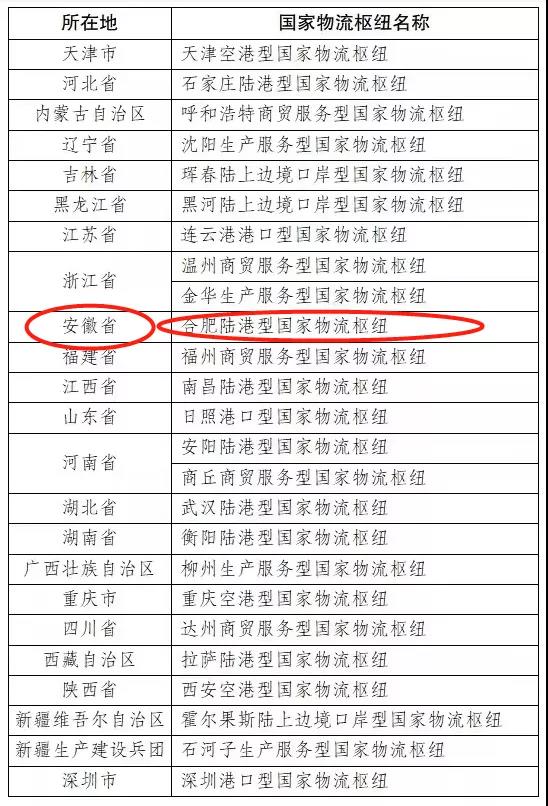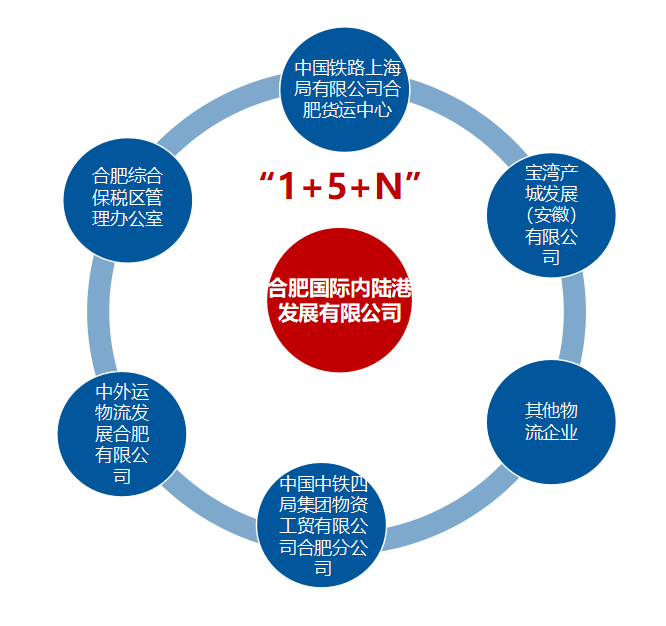Another "national" sign has landed! Hefei City successfully approved as a national logistics hub for dry ports
发布日期:2021-12-01 浏览次数:1228
On 29 November, the National Development and Reform Commission announced the list of national logistics hubs to be built in 2021, and the Hefei Dry Port National Logistics Hub (hereinafter referred to as "Hefei Dry Port Hub"), led by Hefei International Inland Port Development Co. This will promote Hefei's accelerated integration into the "Belt and Road" construction, further strengthen Hefei's position as a logistics centre in the Yangtze River Delta region, and help achieve greater openness to the outside world and create a new highland of inland opening.

The Hefei Dry Port Hub is a "two-zone" linkage model, covering a total area of 4,143 mu (2.76 square kilometres), which has been included in the land use planning. Zone 1 is mainly based on the Hefei International Dry Port Base and the North Station Railway Logistics Base, covering an area of 3,300 mu, accounting for 80% of the total area of the hub. The functional layout of "five clusters and ten districts". Area 2 covers an area of 843 mu, mainly relying on the Hefei Comprehensive Free Trade Zone to provide international logistics service support for Area 1, and to build a cross-border e-commerce commodity display and trading centre in the Yangtze River Delta region.
The Hefei Dry Port Hub adopts a "government-led, enterprise-driven" model, with Hefei International Inland Port Development Co., Ltd. as the lead unit for the construction and operation of the main body, organising the construction of public welfare and platform projects, and undertaking the operation and monitoring data reporting. Hefei North Station Railway Logistics Base, Baowan International Logistics Centre, China Railway Four Bureau of Intelligent Logistics Park, Sinotrans Hefei, Hefei Comprehensive Free Trade Zone focus on participating in the construction of hub logistics facilities, and other logistics enterprises to interact well, forming a "1 + 5 + N" mode of cooperation and construction.

Hefei land port hub to a hub alliance to jointly promote the construction and operation of the hub, a comprehensive information service platform for each hub enterprises to provide efficient and convenient information services, a set of perfect institutional mechanisms to ensure the implementation of the work, a set of functional specialization, efficient hub facilities hub enterprises to provide efficient services, a set of accurate policy system for the construction of the hub to escort the construction and operation system. After completion, it can meet the international transport, multimodal transport, bonded logistics, circulation and processing, international trade and other business needs, the future can achieve the optimization of regional logistics system, improve logistics operational efficiency, support the development of related industries, promote regional economic and social development, and ultimately meet the people's multi-level, diversified, personalized logistics needs and other goals.
The national logistics hub is planned and constructed with the following requirements.
Good location conditions. Adjacent to ports, airports, railway yards and other important transport infrastructures and industrial agglomerations, the distance from urban centres lies within an economically reasonable logistics radius and matches the division of labour in urban agglomerations.
Intensive spatial layout. The main focus is on a contiguous and centralised layout, with logistics facilities set up centrally and land resources used intensively. In principle, no more than two facilities with complementary functions will be scattered in the same national logistics hub.
Prioritisation of existing facilities. The main focus is on improving and upgrading the hub functions of the completed logistics facilities, with appropriate integration, relocation or construction of new hub facilities where necessary in line with regional economic development needs.
Strong openness and public character. The hub should be able to provide public logistics services, guide the orderly gathering of scattered resources and promote the intensive development of regional logistics, and play a backbone role in meeting the logistics needs of regional production and life.
Perfect service functions. It has functions such as trunk transport, regional distribution, as well as multimodal transport facilities and equipment, system integration, interconnection and compatible public information platform, etc. It can provide customs clearance, bonded and other international logistics-related services as required.
Integrated operation and management. A single enterprise or multiple enterprises will jointly lead the construction, operation and management of the national logistics hub, co-ordinate the deployment of logistics service resources, integrate and dovetail logistics services, and implement unified safety and operational standards.
Regional synergy. Encourage different types of national logistics hubs within the same host city to strengthen synergies or merge construction to enhance comprehensive service functions; support host cities in Beijing, Tianjin, Hebei, Yangtze River Delta and Pearl River Delta regions to cooperate and build national logistics hubs within city clusters to realise complementary advantages.


